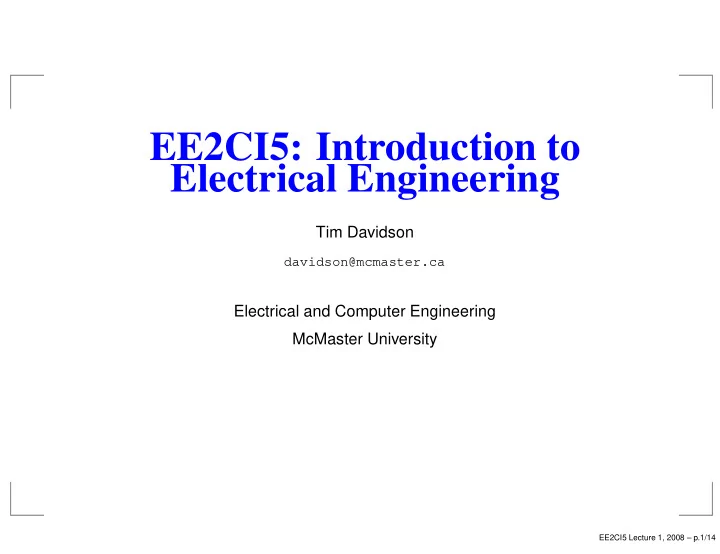

EE2CI5: Introduction to Electrical Engineering Tim Davidson davidson@mcmaster.ca Electrical and Computer Engineering McMaster University EE2CI5 Lecture 1, 2008 – p.1/14
Contact Details Tim Davidson ITB-A310 Ext: 27352 davidson@mcmaster.ca with subject line EE2CI5 Course Web Site: www.ece.mcmaster.ca/faculty/reilly/EE2CI4 login: [removed] password: [removed] EE2CI5 Lecture 1, 2008 – p.2/14
Class Details Lectures: Monday, Wednesday, Thursday: 10:30-11:20, T13/125 Tutorial: Wednesday 13:30-14:20, PC/155 Labs: According to Registrar’s schedule: Mon-Fri 2:30-5:30, ITB A114. EE2CI5 Lecture 1, 2008 – p.3/14
Marking Scheme Qualifying score: Let x % be midterm score and y % be the final exam score. To be awarded a mark for the course you will need to have 25 x/ 100 + 40 y/ 100 ≥ 32 . 5 That is, you have to pass the weighed combo of the midterm and final. Marking scheme: If you obtain a qualifying score 5 Quizzes (during tutorials) = 15% Midterm test (late Oct or early Nov) = 25% Lab and reports = 20% Final exam (3 hours) = 40% EE2CI5 Lecture 1, 2008 – p.4/14
Important Notices All labs must be completed by all students Statistical adjustments (e.g., “bell curving”) will not normally be used Missed tests, quizzes and labs will be assigned a mark of zero, unless there is formal approval of the reason (by the Assoc. Dean’s office) The instructors reserve the right to conduct any formally deferred test or examination orally EE2CI5 is a prerequisite for some third-year courses EE2CI5 Lecture 1, 2008 – p.5/14
So what is this course about? What is electricity? (Physics) How can we use it? (Engineering) Fundamental analysis and design techniques for electrical and electromagnetic circuits Core skill set for 4 courses EE2CJ4, EE2EI5, EE2EJ4, EE3PI4, Intuition developed here will be used throughout the rest of the program Development of structured problem solving skills EE2CI5 Lecture 1, 2008 – p.6/14
Applications Radio-frequency circuit design: wireless & space communications; radio; TV; Cable/ADSL modems Integrated circuit design Biomedical instruments: MRI/CAT/PET machines; microsurgery Aero-space: flight control; autopilot; radar; CanadaArm; Robotics and automated manufacturing Audio amplifiers; hearing aids Analysis and prediction of the stock market EE2CI5 Lecture 1, 2008 – p.7/14
Outline of Topics Current and voltage Ohm’s Law, power and energy Series circuits Parallel circuits Thevenin and Norton equivalent circuits Capacitance and inductance Review of complex numbers Phasors Response of circuits to sinusoidal signals Impedance, admittance and power EE2CI5 Lecture 1, 2008 – p.8/14
Engineering Problem Solving In this course you will develop an ability to analyze circuits that you have not seen before. To do so, you must understand and practice the structured analysis methods we develop Do not make up your own “rules” or “short cuts” based on the answers to one or two problems This will be tested On the test and exam, expect to see problems that you have never seen before EE2CI5 Lecture 1, 2008 – p.9/14
Structured problem solving 1. Break down each complicated problem into small simple parts or steps. (Like a “free body diagram”) 2. Write down a simple equation which describes each part 3. Collect the equations together, and then use straightforward (linear) algebra to solve them This needs practice! EE2CI5 Lecture 1, 2008 – p.10/14
Some Friendly Advice Make sure that you understand what is taught. Actively participate in lectures The slides posted on the web will be incomplete Actively participate in tutorials Actively participate in labs Read the text and courseware Practice problem solving EE2CI5 Lecture 1, 2008 – p.11/14
Exam Preparation Do at least half of the assigned problems under exam conditions If you need a worked example, check the exercises in the book, or the worked examples on the companion web site Think about the principles of what you are doing: Do not waste time memorizing formulae, or solutions to particular circuits Spend your time practising your problem solving skills EE2CI5 Lecture 1, 2008 – p.12/14
Exam Technique Spend a couple of minutes deciding how much time to spend on each question. Once you have decided stick to it! Explain the logic behind your solution method. This is best done by inserting a phrase or sentence between every few lines of your mathematical derivation. Just like in the text book. Demonstrating that you have a viable solution method is the key to obtaining “part marks” Make sure that your answer makes engineering sense. If it does not, let me know, otherwise you might get zero just for getting a minus sign wrong. EE2CI5 Lecture 1, 2008 – p.13/14
Useful Mathematical Skills Algebraic solution of simultaneous (linear) equations Complex arithmetic Logarithms and Exponentials Sketching a function and writing a mathematical description from a sketch By exam time you will need to be fluent in these areas. EE2CI5 Lecture 1, 2008 – p.14/14
Recommend
More recommend